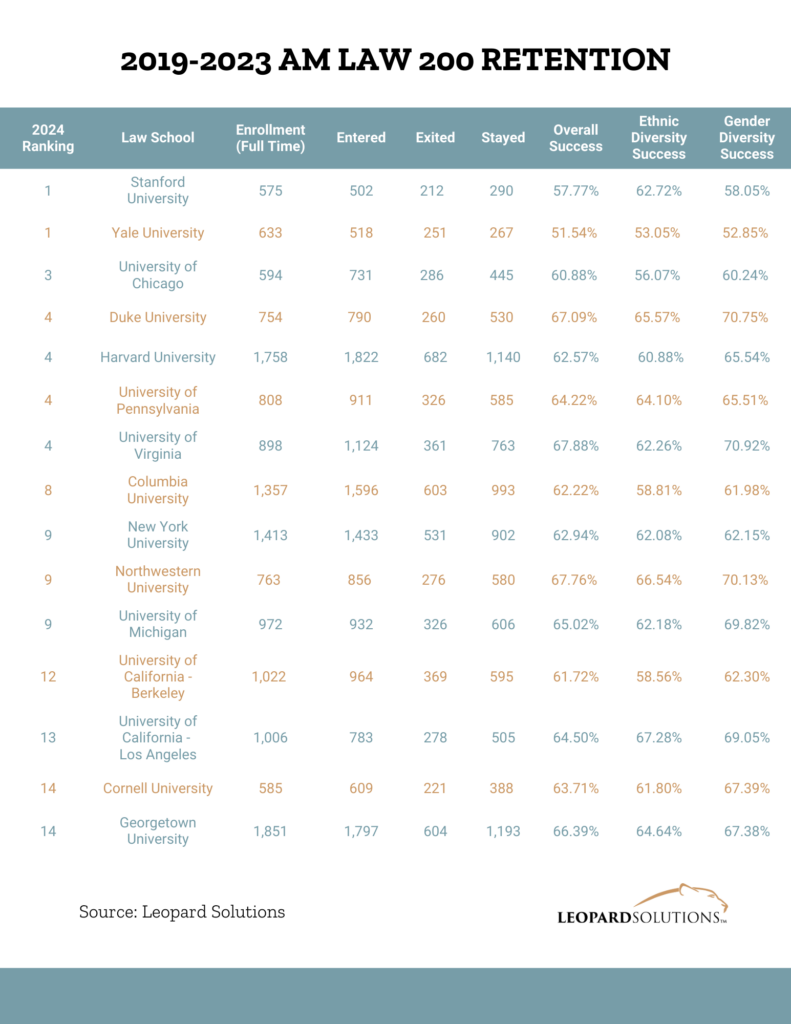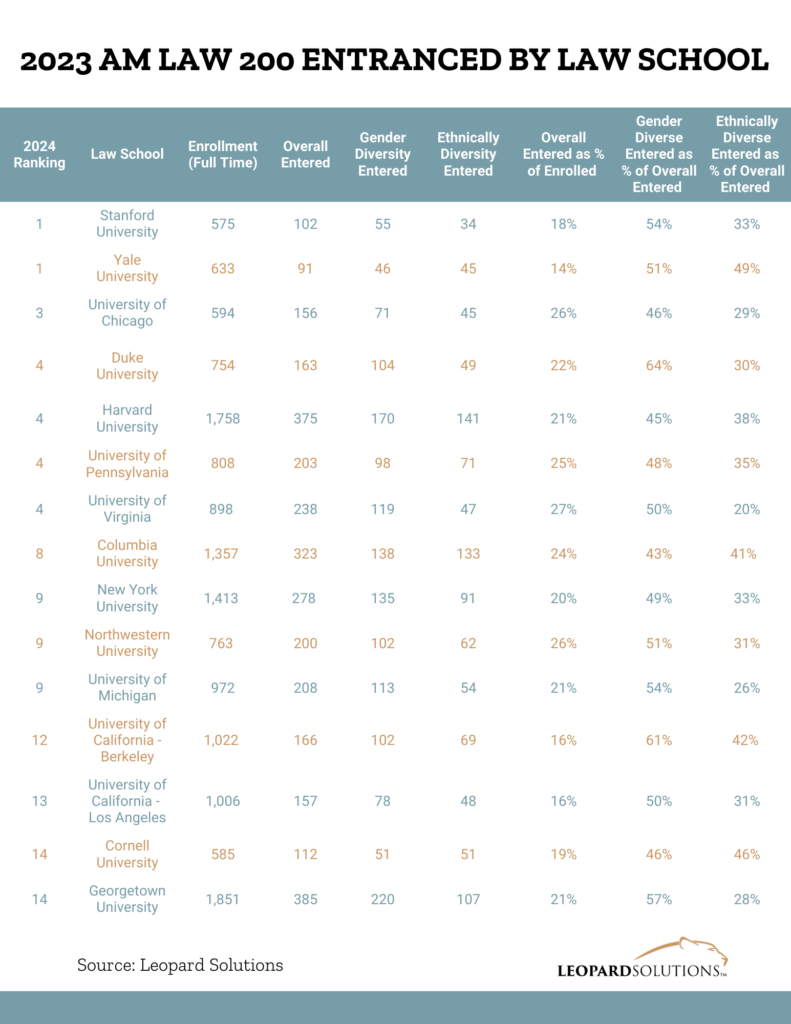Evaluating Big Law Firms’ ROI and DEI Metrics: Which T14 Schools Lead the Way?
U.S. News & World Report released its highly anticipated annual law school rankings this week, determining the industry standard “T14 schools.” The latest edition included adjustments to their methodology aimed at reducing volatility. The ranking considers various indicators, including placement success, bar passage rates, quality assessment, selectivity, and faculty and library resources.
Leopard Solutions, a data provider for the “U.S. News Best Companies to Work For Law Firms” list, tracks entry-level retention success across Am Law 200 firms and attorney migrations from underrepresented groups. Leveraging its firm entrance and exit report, Leopard can determine school hires’ return on investment (ROI) across different areas, utilizing a three-year criterion to gauge “success.” Hiring success is based on five years of continuous partner employment and three years for associates and counsel. Given the level of commitment required to attend law school, students should consider not only the U.S. News determinants of prestige schools but also critical “on the ground” metrics that reveal whether schools have adequately prepared their cohort to thrive in the demanding environment of BigLaw.
Below is a comparison of how the top 14 (T14) law schools, as ranked by U.S. News, performed in the workforce of the top 200 firms by gross revenue between 2019 and 2023. It examines entry-level hiring classes from previous years to assess the percentage of attorneys remaining within a minimum three-year benchmark.

Top ranked Law Schools Continue to Lead the Way in Attorney Placements
Fourth-ranked Harvard led the T14 schools with 1822 students placed in Am Law 200 firms over this period, narrowly surpassing Georgetown, which accounted for 1797 incoming junior associates, a difference of just 25 students. Despite the significant number of hires, Georgetown ranked last among the T14 in the core U.S. News ranking. Additionally, Stanford, ranked number one, sent the fewest students to Am Law 200 firms, with only 502, a staggering 72% less than Harvard. Yale, a historically prestigious institution, achieved the lowest success rate at 51.4%. Notably, half of Yale’s hires since 2019 left their top 200 firms, incurring substantial training costs for these firms. While this could be interpreted as Yale graduates having more opportunities to lateral for financial gain, it may also reflect on their preparedness, as it was 16 percentage points lower than the top-performing University of Virginia (UVA) (67.88%) and lower than 13 other similarly reputed schools (one of two with a success rate under 60%). Among non-T14 schools with at least 100 matriculated students hired by Am Law 200 firms over five years, Wake Forest boasted the highest retention rate, with 187 hires and a success rate of 79.68%. In the past year.
Next, we examined the gender and ethnically diverse placements at Am Law 200 firms, with Leopard Firmscape, for the same timeframe. The Leopard Diversity Probability Index utilizes multiple diversity identifiers, excluding distinct ethnicity and personal data, to objectively score a firm or an individual attorney. It considers factors such as first and last name, native country, memberships, law school & undergraduate institution, and mentions of background in firm bios.
The average retention rate for female graduates of T14 schools at Am Law 200 firms between 2019-2023 was 61.18%, 1.9% lower than the overall average of 63.08%. Conversely, the average successful retention of ethnically diverse hires exceeded the overall average by 0.9% (64%).
Note: Attrition rates for the top 200 firms are average, and retention rates at individual firms vary widely. Still, this finding is somewhat surprising given the record-level over-hiring of this demographic in 2020-2021 in response to events like the killing of George Floyd and the subsequent ‘rightsizing’ reaction that occurred over the past two years.
At an institutional level, Duke, UVA, and Northwestern had the highest longevity rates for female graduates, surpassing 70%. Meanwhile, ethnically diverse UCLA graduates achieved the highest successful retention rate, at 67.28%. Twelve T14 schools saw higher successful retention rates among their female graduates than the average overall. At the same time, for minority hires, it was a substantially lower number of three academies.
For 2023 entrants into the labor force, success rates were predictably high across the board, as departures in Q1 of 2024 following such a brief tenure were minimal. Analytically, it made more sense to examine entrances over this time as a percentage of enrollment to compare schools fairly. We applied the same methodology for diverse populations by cross-tabulating as a percentage of overall incoming hires.

Longer term Tracking Shows a Different Tale
For female hiring, UVA was the sole T14 school with double-digit (10) exits among its alumnae in 2023. UC Berkeley boasted the highest percentage of gender-diverse students hired among all its 2023 Am Law 200 entrants, at 61%. Conversely, Columbia had the lowest gender diversity among its 2023 hiring class, at 43%.
When viewed as a percentage of their 2023 full-time enrollment, Columbia was the only T14 school to account for double-digit junior associates hired into the Am Law 200 (10%). Among T14 schools with over a thousand enrolled in 2023, UCLA had the smallest proportionate percentage (5%) snapped up by an AL 200 firm.
UVA had the best year for student placement compared to their 2023 full-time enrollment, with 27% of their postgraduate student body landing coveted roles at America’s top-earning law firms. Duke boasted the highest concentration of gender-diverse entrants, with 64% of all their students joining Am Law firms. Cornell stood out as the only school where the percentage of gender and ethnically-diverse hires were on par, at 46% each. For all other T14 schools, non white or mixed-race hires trailed females as percentages of the total hired. In contrast to other successes, UVA had the lowest rate, with only a fifth of the hires they produced in 2023 representing underrepresented groups.
Tuition and fees for T14 law schools are skyrocketing; for instance, New York schools–Columbia and NYU– are now upwards of $80,000. With such substantial investment, more is needed for students and firms alike to know which names are getting lawyers in the door, but rather which ones are keeping them there, making it lucrative for all parties involved.
Posted on



